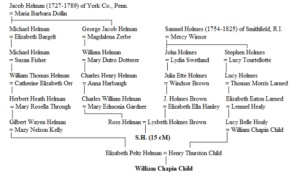While I’ve talked about examples of sharing DNA through two (unrelated) parents, which can occur frequently when one’s ancestors lived in the same area for generations, this example involved a DNA match my father had through both of his parents, who are from different geographic and ethnic backgrounds.
Over several generations, while you may still share autosomal DNA (atDNA) with some distant relatives, there are going to be some relatives where atDNA is no longer shared. Blaine Bettinger’s post from a few years ago found the closest known kinship where atDNA is no longer shared (and where there is not a case of misattributed parentage) is that of second cousins once removed. (To date, no cases of second cousins or closer not sharing atDNA have been found, unless there is something else going on.) I enjoy going through my parents’ matches to see how far back a common ancestor may be. Still, as this example shows, just because you have identified a common ancestor with a shared atDNA match, that does not mean that ancestor was the source of your shared atDNA.
I have found no way that my father’s parents were related to one another. My grandfather was of entirely “New England Yankee” ancestry, while my grandmother’s parents were from Philadelphia of largely German and Irish ancestry (with a small amount of English ancestry via Maryland). My grandmother’s surname of Helman goes back to German immigrant (Johann) Jacob Helman (1727-1789) of York County, Pennsylvania (also spelled Hellmann and Helmann). I was searching my father’s atDNA matches on Ancestry to see his most distantly-related Helman cousin. Within Ancestry are one maternal first cousin and a few children and grandchildren of other first cousins that my father knows.
I have found no way that my father’s parents were related to one another.
One generation further back are second cousins once and twice removed descending from my father’s grandfather’s younger brother. However, the next atDNA matches for my father, where Helman appeared in the matches’ tree, was via a descendant of another son of Jacob Helman. This match, “S.H.,” is a fifth cousin to my father’s mother. It was a small match at only 15 centiMorgans (even I no longer shared atDNA with this person), but certainly within the range for people related at fifth cousins once removed. However, as I looked at this person’s tree, I noticed that my father was also related to this person through his father’s ancestry! My grandfather and S.H. are fourth cousins. The amount of shared atDNA is also consistent for my father’s paternally-derived kinship. Through which parent does my father share atDNA with S.H.?
I really can’t say. As I indicated, this was a small segment match; my father’s sister does not share atDNA with this person, nor do his paternal and maternal first cousins on AncestryDNA as well as other relatives who would share these ancestors. S.H. and my father only have one “shared match” between them, which is one of my father’s paternal third cousins. Does this mean that S.H.’s shared atDNA must be through my father’s father? No. There’s no chromosome browser on Ancestry, and S.H. and my father’s third cousin could have shared atDNA ... but not at the same place as my father. Some things are possible with advanced tools on GedMatch and GDAT, but that would take much more time, and might not lead to any firmer conclusion. I have had one of my male second cousins with the Helman surname participate in Y-DNA testing (and he matches to other Helmans).
So, while I can’t say anything particular on my father’s small segment atDNA match, I can say that even though my paternal grandparents (who married in 1941 in Connecticut) were not related to one another, sixteen years before their marriage, in 1925 (in Ohio), my grandfather’s fourth cousin married my grandmother’s fifth cousin, and neither couple ever knew the other!
Share this:
About Christopher C. Child
Chris Child has worked for various departments at NEHGS since 1997 and became a full-time employee in July 2003. He has been a member of NEHGS since the age of eleven. He has written several articles in American Ancestors, The New England Historical and Genealogical Register, and The Mayflower Descendant. He is the co-editor of The Ancestry of Catherine Middleton (NEHGS, 2011), co-author of The Descendants of Judge John Lowell of Newburyport, Massachusetts (Newbury Street Press, 2011) and Ancestors and Descendants of George Rufus and Alice Nelson Pratt (Newbury Street Press, 2013), and author of The Nelson Family of Rowley, Massachusetts (Newbury Street Press, 2014). Chris holds a B.A. in history from Drew University in Madison, New Jersey.View all posts by Christopher C. Child →
